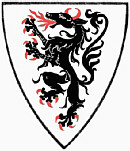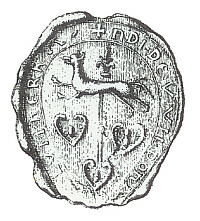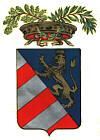Carantanian Heraldry - From Monochrome to Polychrome ...
Societas Heraldica Slovenica
February 2005
by Dr. Jožko Šavli
Carantanian coats of arms are in the grouping with the oldest roots in Europe. Their symbols reflect the state traditions of Carantania (Slovenia), which later passed to Inner Austria. According to confirmed dates, Carantanian official heraldry began in the period after 1150 A.D. The symbols and images upon which it is based, however, are much older. The predecessors of coats of arms were battle signs, usually in the form of aggressive or cunning animals. They symbolized power, bravery and skill in the strategy of battle. Even today, such pre-heraldic battle signs can be recognized of some provinces, among them is also the black panther of Carantania.
 At the beginning of the 20th century, the well-known Styrian heraldist, A. Anthony von Siegenfeld, published detailed resarch concerning the panther. He determined that its origin was preheraldic. However, because his sympathies lay with the pan-Germanic movement in Europe, he extrapolated parts of this preheraldic history, assigning it to Bavaria. His opinions were considered authoritative for many years in the study of Austrian heraldry. At the beginning of the 20th century, the well-known Styrian heraldist, A. Anthony von Siegenfeld, published detailed resarch concerning the panther. He determined that its origin was preheraldic. However, because his sympathies lay with the pan-Germanic movement in Europe, he extrapolated parts of this preheraldic history, assigning it to Bavaria. His opinions were considered authoritative for many years in the study of Austrian heraldry.
It is still the case that Austrian heraldry, like its historiography, does not recognise Carantania as a predecessor state to Austria and also to today Slovenia. It follows, therefore, that Carantanian heraldry has received little scholarly attention.
For the above reason the question of the pre-heraldic and Carantanian origin of the black panther on a silver shield has not been adequately explained. The figure has always been known as the 'Styrian' panther as depicted on the left. The only logical reason for this, at least in recent times, is the fact that studies of Carantanian statehood have not been fully explored.
Proof of the existence of panther battle sign is shown on the insignia of 1195 pertaining to Herrald von Wildon, Marshall of the Carantanian March (later Styria). It shows the panther on a pole depicted on the image on the right. 
The insignia, 1195 pertaining to
Herrald von Wildon |
The appearance of battle symbols on the shields of rulers marks the beginning of the heraldic period. The first record of the figure of a panther on a shield appears on an insignia in 1160. This demonstrates that Carantania was among the first European nations to have their own coat of arms and also its own flag. The figure of the panther first appeared on a gonfalon in 1205. The panther's colors were described for the first time by Wolfram von Eschenbach in "Parzival" around the year 1210, where he mentions the "sable (black) panther on an ermine shield" which is later a black panther on a silver (argent) shield.

Today's coat of arms
for the Province
of Gorizia |
These Carantanian colours - black-white - were used in the coats of arms of families that occupied positions of prominence whithin the state administration and army already in the period of the Great Duchy of Carantania (952 - 1180) which comprised the territory of the Eastern Alps and Northern Italy between Vienna and Verona. The oldest families of Carantania (today Carinthia and Styria) used black and white coats of arms. Osterwitz, Liechtenstein, Stubenberg and others. In the March of Treviso, the Collalto family being Counts there in the Carantanian period already in about the year 1000, bore a black and white coat of arms. Similarly, the arms of the Colloredo family in Friuli and so on.
After the decline of the Carantanian dynasty, around 1270, the shield with the black panther was no longer used. This symbol remained only in the form of the white panther, still used in Styria to this day.
The domination of the Habsburg family over the Carantanian lands after 1335 brought with it a new name for the region, Inner Austria. The Carantanian heraldry passed over into the Austrian. A new heraldry used elements of both. The colours red and white were more in fashion then, and the bundle of so-called 'Austrian Peacock' feathers was favoured. However the banner with the figure of the panther was retained as the sign of ancient statehood. The origin of this symbol lies, as we have seen, in Carantania. It continued as an Austrian symbol until 1440 when Duke Frederic V was elected King, and later become Emperor Frederic III. From that time the Imperial symbols supplanted all others.
Bibliography
- Bartsch, Z. Steiermärkisches Wappenbuch 1567. (Faksimilausgabe von J. von Zahn und A. von Siegenfeld), Graz. 1893.
- Siegenfeld, Alfred Ritter Anthony von. Das Landeswappen der Steiremark. Graz, Verlags-Buchhandlung Styria, 1900.
About the author: Dr. Jožko Šavli, born 1943 in Tolmin, Slovenia, obtained a degree in Business Management at the University of Ljubljana in 1967, and continued with his studies at the University of Vienna, where he obtained a Doctorate in Social and Economic Sciences in 1975. Since 1978, he has been teaching at the Slovenian Technical School of Commerce in Gorizia, Italy.
He developed a passionate interest in Slovenian history while studying in Vienna, which prompted him to further his research in the subject, resulting in a number of articles published, with a focus on the Slovenian Medieval State of Carantania. His first article appeared in Archivum Heraldicum (1982, No. 3-4) which examined the history of the black panther as the original coat of arms of Carantania. He has written a number of books, the latest entitled "Slovenia: Discovering a European Nation" examines in more detail, the history of Slovenia from the very earliest stages during the Paleolithic period, with most emphasis during the medieval period to modern day.
Societas Heraldica Slovenica
February 2005
SHS Copyright © 2005 All Rights Reserved
|